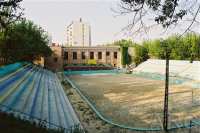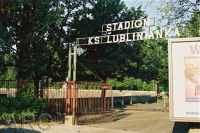Wieniawa was a suburb of the city of
Lublin.
Immediately before WW2, most inhabitants of
Wieniawa
were Jewish (about 75% of the population). It was an old Jewish community, established in the 17th century,
with its own synagogue and cemetery. During WW1 this community and the entire suburb were
incorporated into the city of
Lublin.
Wieniawa,
although very close to the elegant centre of the city, was very poor. The dwellings consisted in the main of
wooden houses. The largest building was the synagogue erected in the 18th Century, which was situated exactly
in the centre of the suburb.
When
Lublin was captured by the German Army,
Wieniawa, located in the streets neighbouring the German administration district,
was incorporated within that district. There was no longer any space for the Jews. In
March 1940, the entire Jewish population of
Wieniawa
was resettled in the
Lublin Ghetto. From that time, groups of Jews from
Lublin were led to
Wieniawa in order to
destroy Jewish housing. According to the plans drawn up by
Odilo Globocnik, the suburb was designated to be an area for the
building of recreational facilities for the SS and the general German population of
Lublin.
 |
| Former Swimming Pool |
The first construction work was undertaken in
1940-1941. The Jewish
cemetery was totally destroyed and the tombstones were used for building material in the German district (some of
these tombstones were discovered in
1994 during renovation work on the courtyards of former
German houses and were replaced in the New Jewish Cemetery in
Lublin).
In
1941, the SS began to build a sports stadium and swimming pool on part of
Wieniawa`s Jewish cemetery. The forced labourers were Jews from the
Lublin Ghetto and, according some testimonies, a group of French prisoners of
war who were located in one barrack on
Leszczynskiego Street.
From inception, the site of the work camp was called
SS-Sportplatz (sports field) by both the
Germans and the prisoners.
In
spring 1942, with the commencement of
Aktion Reinhard, a regular work camp was established
on
Ogrodkowa Street, close to the
Sportplatz. It is unclear whether,
from inception, the prisoners of this camp consisted solely of Jewish prisoners who were taken from the
Majdanek concentration camp, or if amongst them were also Jews who were selected
from the
Lublin Ghetto during the time of the deportations to the
Belzec death camp.
The main building of the camp was located in the former cosmetic factory, which had been confiscated
as Jewish property. The factory belonged to engineer
Roman Keindel, who
before the war was the owner of the famous
Lublin cosmetic company
Erika.
During the war,
Keindel, although removed as the owner of the factory, still worked there
as the principal specialist. From the time of the establishment of the camp, he was a kind of
Lagerkapo
at the
Sportplatz camp.
 |
| The big Stadium |
The factory was in the largest of the buildings, and from
spring 1942 it was
surrounded by barbed wire.
The prisoners slept and worked in the same building, and SS guards were also stationed there. Later,
at the
end of 1942, two or three barracks were built near the factory building.
At the commencement of the
camp's activities, some of the Jewish prisoners were led there every day from
Majdanek concentration
camp. It was only after the barracks were built that a permanent group of the prisoners lived there. The
Sportplatz became a subcamp of
Majdanek, called
SS-Polizeiführerkommando Sportplatz.
In
1942, the prisoners numbered about 600 people in total. Because of the
lack of survivors' testimony, it is
difficult to say if some of the prisoners also worked in the factory at that time, or if they were only
employed in the construction works on the stadium. First hand sources about the conditions of life in the camp
do not exist, but according to some testimonies, the prisoners who were at the
Sportplatz (among them
Jews from
Lublin) had greater possibilities of contact with Poles, from whom they
bought food. Groups of Jewish prisoners of war from the
Lipowa Street Camp were also brought to the
Sportplatz every day
and some fellow prisoners had the opportunity of exchanging information and food with them. The construction
works on the SS-stadium were not directly connected with
Aktion Reinhard, but the fact that Jewish prisoners
from
Majdanek were utilised there meant that the building activities effectively
became a part of
Aktion Reinhard.
The other part of the
Sportplatz camp - the building of the cosmetic factory - had a more immediate connection
with
Aktion Reinhard. From the beginning of
1942, the normal production
of cosmetics was abandoned.
Rather, the building was converted into a special store for cosmetics, medication and surgical equipment.
These had been confiscated either from Jewish deportation transports, during the liquidation of the ghettos
in the
Generalgouvernement, or directly from the suitcases belonging to the victims of
Belzec,
Sobibor,
Treblinka, and
Majdanek camps.
Artificial limbs were also gathered here, repaired and dispatched. According the
sole survivor of the
Sportplatz camp,
Dora Minc (Julia Celinska), it was
a very large "factory" in which all of these things were segregated and utilised. A part of them was transferred to
German army hospitals in
Lublin; the remainder was sent to the
Reich.
The commandant of the camp was
SS-Standortarzt Sturmbannführer
Dr
Kurt Sickel, who
Dora Minc considered to
be a liberal person. In fact, the individual who played the main role in the camp was Mrs
Radischat, with whom
Globocnik
had an affair and who was also the lover of Dr
Sickel.
She supervised the prisoners in the factory and also participated in the private plunder of Jewish property in
Lublin. She was very cruel to the prisoners.
The
Sportplatz camp existed until
3 November 1943, that is, until the
Erntefest mass execution. In
May 1943, the number of Jewish prisoners
from
Majdanek who worked there was reduced
to 149 people. Because
of the lack of documentation, it is not known if this was the total number prisoners working in the entire
camp or only represents the group which built the SS-stadium. It is probable that the prisoners who worked
in the cosmetic factory were excluded from the documentation of
Majdanek
concentration camp and were registered as special work prisoners of
Aktion Reinhard.
 |
| The Sportplatz today |
According to
Dora Minc, there was a kind of resistance group among the prisoners
in the factory. They were preparing for a mass escape from the camp at the moment of its liquidation. The leader of
this group was
Roman Keindel, who had connections with the Polish resistance.
Due to his contacts with the Poles, he was able to organize hiding places in
Lublin
for the group of would-be
escapers. However, the liquidation of the camp was planned by the Germans in secrecy, and nobody from the group had
made preparations to escape when the time arrived. Early in the morning, trucks arrived on the
Sportplatz
and all of the prisoners were loaded onto them. Only
Dora Minc, who worked
outside the camp in the house of Mrs
Radischat, escaped at the last moment.
She saw how
Keindel commited suicide by taking poison.
After the
Aktion Erntefest the camp was closed. The factory
building remained standing until the
late 1970's,
at which time it was demolished and new apartment blocks were built on the camp site. The old
SS-stadium still exists today and is used as a sports complex for the
Lublin sports
club "Lublinianka".
The stadium occupies part of the former Jewish cemetery. No memorial has been erected to indicate
the existence of either the camp or the destroyed cemetery that once stood there.
Sources:
Archive of the Majdanek State Museum,
The Jewish Memoirs
Archive of the Regional Commission for the Investigations of the Nazi Crimes in Lublin,
Investigation about the Camp on Leszczynskiego street
Majdanek 1941-1944, Red. By T. Mencel, Lublin 1991
T. Radzik:
Lubelska dzielnica zamknieta, Lublin 1999
© ARC 2005












